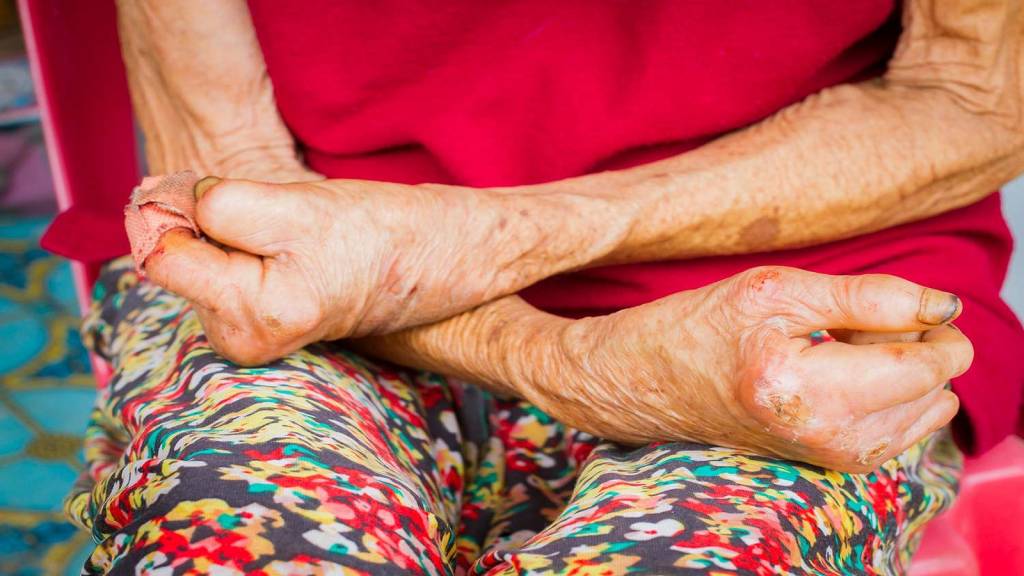Leprosy, also known as Hansen’s disease, is a chronic infectious disease caused by the bacteria Mycobacterium leprae. It primarily affects the skin, peripheral nerves, upper respiratory tract, and eyes. Despite its historical stigma, leprosy is a curable disease, especially when diagnosed and treated early. Here’s an in-depth look at leprosy:
Causes and Transmission:
- Bacteria: Mycobacterium leprae.
- Transmission: Not highly contagious. Thought to be spread through prolonged close contact with an infected person, likely via droplets from the nose and mouth.
Symptoms:
Leprosy presents with a wide range of symptoms depending on the type and severity of the disease. The symptoms can take several years to appear after the initial infection.
- Skin Symptoms:
- Hypopigmented or Red Patches: Areas of skin with reduced or lost pigmentation, often with reduced sensation.
- Nodules: Raised bumps or lumps on the skin.
- Thickened Dermis: Skin thickening, particularly on the face and ears.
- Ulcers: Chronic skin ulcers on the soles of the feet.
- Nerve Symptoms:
- Numbness: Loss of sensation in affected areas, especially in the hands, feet, and face.
- Muscle Weakness: Muscle weakness, often in the hands and feet.
- Peripheral Neuropathy: Damage to the peripheral nerves leading to numbness, tingling, and pain.
- Nerve Enlargement: Swelling of peripheral nerves, particularly around the elbows and knees.
- Other Symptoms:
- Eye Problems: Including dryness, reduced blinking, and vision problems if the facial nerves are affected.
- Nasal Congestion and Nosebleeds: Due to the involvement of the nasal mucosa.
Types of Leprosy:
Leprosy is classified based on the number and type of skin lesions, and the extent of nerve involvement:
- Tuberculoid Leprosy:
- Fewer, well-defined skin lesions.
- Less severe, with limited nerve involvement.
- Lepromatous Leprosy:
- Numerous, widespread lesions including nodules and plaques.
- More severe, with significant nerve involvement and higher bacterial load.
- Borderline Leprosy:
- Intermediate between tuberculoid and lepromatous.
- Can shift toward either form over time.
Diagnosis:
- Clinical Examination: Visual inspection of skin lesions and assessment of sensory loss.
- Skin Smear Test: Microscopic examination of samples from skin lesions for M. leprae.
- Biopsy: Skin biopsy to look for histopathological signs of leprosy.
- Lepromin Skin Test: Used for classification of the type of leprosy but not for diagnosis.
Treatment:
Leprosy is treated with a combination of antibiotics, known as multidrug therapy (MDT), to prevent resistance and effectively cure the disease.
- Multidrug Therapy (MDT):
- Rifampicin: Effective against M. leprae.
- Dapsone: Another effective antibiotic.
- Clofazimine: Added for lepromatous and borderline cases.
- Duration of Treatment:
- Paucibacillary Leprosy: Typically 6-12 months.
- Multibacillary Leprosy: Typically 12-24 months.
- Supportive Treatments:
- Physical Therapy: To maintain mobility and prevent disabilities.
- Wound Care: For ulcers and skin lesions.
- Surgery: In some cases, to correct deformities or restore function.
Complications:
- Nerve Damage: Permanent disability or deformity due to untreated nerve damage.
- Blindness: Due to eye involvement.
- Chronic Ulcers: Leading to secondary infections.
- Stigma and Discrimination: Psychological and social impact due to historical misconceptions.
Prevention:
- Early Diagnosis and Treatment: To prevent transmission and complications.
- Contact Tracing: Identifying and treating contacts of infected individuals.
- Vaccination: BCG vaccine provides some protection against leprosy.
- Education and Awareness: Reducing stigma and promoting early medical consultation.
Global Context:
Leprosy is more common in tropical and subtropical regions, particularly in countries such as India, Brazil, and Indonesia. Global efforts are ongoing to reduce the prevalence of leprosy through early diagnosis, treatment, and education.
Living with Leprosy:
With effective treatment, individuals with leprosy can lead healthy, productive lives. Rehabilitation and support services are important for those with disabilities resulting from the disease.


Leprosy is no longer the feared disease it once was due to advances in medical treatment and understanding. Early detection and proper treatment are crucial for a complete cure and preventing complications.

